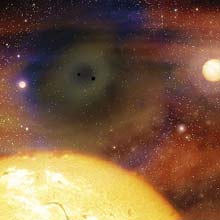The universe just became a little simpler

Artist’s impression of two black holes evacuating the center of a galaxy. Credit: Gabriel Perez Diaz; MultiMedia Service; Instituto de Astrofísica de Canarias (IAC).
Using images from the Hubble Space Telescope, astronomers have concluded that two of the most common types of galaxies in the universe are in reality different versions of the same thing. In spite of their similar-sounding names, astronomers had long considered “dwarf elliptical” and “giant elliptical” galaxies to be distinct objects. The new findings, which appear in this month’s edition of The Astronomical Journal, fundamentally alter astronomers’ understanding of these important components of the universe.
Galaxies, the building blocks of the visible universe, are enormous systems of stars bound together by gravity and scattered throughout space. There are several different types, or shapes. For example, the Milky Way galaxy, in which the Earth resides, is a “spiral” galaxy, so named because its disk-like shape has an embedded spiral arm pattern. Other galaxies are known as “irregular” galaxies because they do not have distinct shapes. But together, dwarf and giant elliptical galaxies are the most common.
For the past two decades, astronomers have considered giant elliptical galaxies, which contain hundreds of billions of stars, and dwarf elliptical galaxies, which typically contain less than one billion stars, as completely separate systems. In many ways it was a natural distinction: not only do giant elliptical galaxies contain more stars, but the stars are more closely packed toward the centers of such galaxies. In other words, the overall distribution of stars appeared to be fundamentally different.
Alister Graham and Rafael Guzmán from the University of Florida decided to take a second look at the accepted wisdom. Expanding on work started by Graham at the Instituto de Astrofísica de Canarias (IAC) in Spain, the pair analyzed images of dwarf elliptical galaxies taken by the Hubble Space Telescope and combined their results with previously collected data on over 200 galaxies. The resulting sample revealed distributions of stars displaying a continuous variety of structures between the allegedly different dwarf and giant galaxy classes – in other words, these two types were just relatively extreme versions of the same object. Moreover, there was one rather interesting caveat.
In recent years, Graham said, a number of studies had revealed that the innermost centers of giant elliptical galaxies – the inner 1 percent – had been scoured out or emptied of stars. Astronomers suspect that massive black holes are responsible, gravitationally hurling away any stars that ventured too near and devouring the stars that came in really close. This scouring phenomenon had tended to dim the centers of giant elliptical galaxies, which ran counter to the trend that bigger galaxies tend to have brighter centers. The dimming phenomenon was one reason astronomers had concluded dwarf and giant galaxies must be different types.
Together with Ignacio Trujillo of the Max-Planck Institut für Astronomie in Germany and Peter Erwin and Andres Asensio Ramos of the IAC, Graham addresses this phenomenon in a separate article that appears in the same issue of The Astronomical Journal. Building on recent revelations showing a strong connection between the mass of the central black holes and the properties of their host galaxies, Graham and his colleagues introduced a new mathematical model that simultaneously describes the distribution of stars in the inner and outer parts of the galaxy. “It was only after allowing for the modification of the cores by the black holes that we were able to fully unify the dwarf and giant galaxy population,” Graham said.
“This helps to simplify the universe slightly because we can replace two distinct galaxy types with one,” said Graham. “But the implications go beyond mere astronomical taxonomy. Astronomers had thought the formation mechanisms for these objects must be different, but instead there must be a unifying construction process.”
Sidney van den Bergh, former director and researcher emeritus at the Dominion Astrophysical Observatory at the National Research Council of Canada in Victoria, said Graham and Guzmán’s result puts to rest a “very puzzling” question.
“In astronomy, like in physical anthropology, there is a deep connection between the classification of species and their evolutionary connections,” van den Bergh said. “The bottom line is that the new work of Graham and Guzmán has made life a little bit simpler for those of us who want to understand how galaxies are formed and have evolved.”
Media Contact
More Information:
http://www.iac.es/gabinete/noticias/2003/m06d16.htmAll latest news from the category: Physics and Astronomy
This area deals with the fundamental laws and building blocks of nature and how they interact, the properties and the behavior of matter, and research into space and time and their structures.
innovations-report provides in-depth reports and articles on subjects such as astrophysics, laser technologies, nuclear, quantum, particle and solid-state physics, nanotechnologies, planetary research and findings (Mars, Venus) and developments related to the Hubble Telescope.
Newest articles

An Endless Loop: How Some Bacteria Evolve Along With the Seasons
The longest natural metagenome time series ever collected, with microbes, reveals a startling evolutionary pattern on repeat. A Microbial “Groundhog Year” in Lake Mendota Like Bill Murray in the movie…

Witness Groundbreaking Research on Achilles Tendon Recovery
Achilles tendon injuries are common but challenging to monitor during recovery due to the limitations of current imaging techniques. Researchers, led by Associate Professor Zeng Nan from the International Graduate…

Why Prevention Is Better Than Cure—A Novel Approach to Infectious Disease Outbreaks
Researchers have come up with a new way to identify more infectious variants of viruses or bacteria that start spreading in humans – including those causing flu, COVID, whooping cough…



